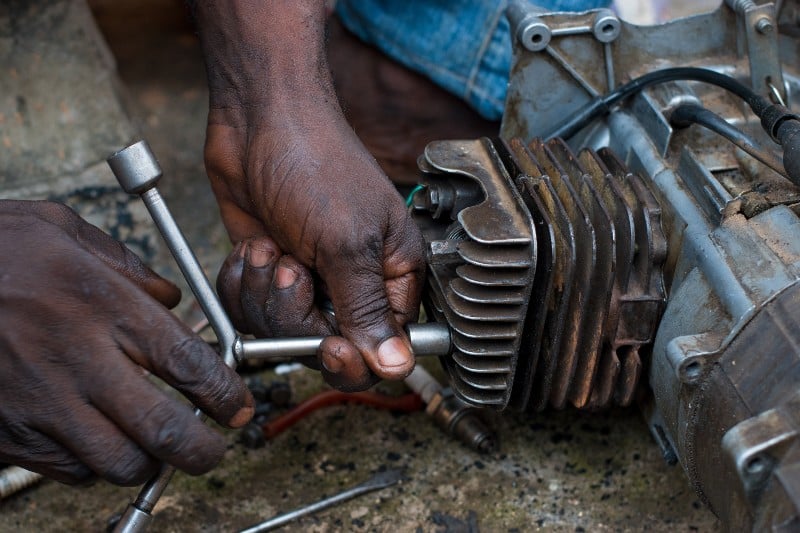Today’s guest blog post was contributed by Oladimeji Shotunde from the Global Prosperity group.
For the average store-owners in Nigeria, maintaining supplier relationships, fulfilling customer orders, and managing inventory are just a tip of the iceberg of what they must do to run their businesses. Dealing with Nigeria’s severe lack of electricity is an additional burden. Nigeria’s energy deficit–the largest in the world–costs Nigerian businesses $29 billion annually, and 2% of the country’s GDP. As a result, many businesses and homes have found a workaround in diesel and gasoline generators.
The Energy Commission of Nigeria revealed that individuals and businesses spend $22 billion annually to fuel generators. Nigeria boasts an estimated 3 million, about 46%, of the 6.5 million generators sold in Sub-Saharan Africa. The collective capacity of the 22 million generators in Nigeria (~42 GW) is eight times the capacity of the national grid (~5.4 GW). The diffusion of generators in Nigeria cuts across income levels and geographies.
How did Nigeria, a poor country, achieve such a high rate of generator diffusion?
The Jobs to Be Done theory can shed a light on why Nigerians easily consume generators. Jobs theory reinforces going beyond market demographics and product attributes to expose the functional, social, and emotional dimensions that explain why customers make the choices they do. By functional, the product/service must function in a way that helps the consumer overcome a struggle. The social dimension of the job is about the way others view the consumer using the product or service, while the emotional dimension of the job is about how the product or service makes the consumer feel. In addition to explaining customer behavior and what their consumption priorities are, Jobs theory can also offer a lens to view and understand how the market for generators was created in Nigeria.
Jobs Theory lens: What drove generator diffusion in Nigeria?
Globally, 75 percent of backup generators are deployed in grid-connected areas, indicating that the prevalence of unreliable grids is a driver of generator adoption. Nigeria is beset with extremely unreliable grids but this cannot singularly drive generator adoption.
First, when it comes to a functional component of generators, consider both their reliability and affordability. From a reliability standpoint, generators, depending on the size, provide the necessary electricity to power appliances in the home and equipment in factories and businesses. Regarding affordability, within the past two decades, portable generators have ranged from between N10,000 ($65, 2010 rates) to over N100,000 ($150, 2023 rates). For many Nigerians this represents a relatively accessible alternative to other sources of electricity.
In addition, prior to May 29th, 2023, the cost of gasoline was heavily subsidized by the Nigerian government. This advanced the belief amongst Nigerians that provided they could purchase a generator; maintenance and fueling would not be a struggle. Low product and fuel costs along with the ‘availability’ of gasoline to power generators, as evidenced by the wide dispersion of fueling stations across Nigeria, have made generators a more receptive alternative.
Second, the emotional component of the Job that generators help accomplish is the feeling of independence it gives to consumers, as they are made to believe they have control over when and how they accessed energy. In addition, there is an ease in maintenance and repairs. Both repair artisans and spare part shops are widely available within neighborhoods. Self-repair is also an option as non-artisans leverage improvisation and experimentation to decipher likely generator faults. The flexibility experienced with repairs can be labeled a modularity/replacement advantage. Defective component parts are easily purchased from small electronic stores dispersed around and replaced with ease—in some cases, without professional help.
Third, there is a ‘wholesomeness’ factor to generators, meaning they require no additional components, except for installation to household power changeovers. This also implies installation is easier, as it can be done in half an hour, even without expert assistance—the same cannot be said of alternative energy sources such as solar.
Finally, generator ownership can also be used to reinforce social status. Generators come in ranging kVA ratings and prices. From the inexpensive portable generators that are now popularly referred to as “I better pass my neighbor,” to the high-capacity ones deployed in industries and companies, it is hard to ascribe “generator” to an income class. This has ‘normalized’ generator ownership and many households have an unstated mental obligation to possess one.
A lesson from generator diffusion is that the (product) solution aligns with the priorities and realities of consumers. As explained by Jobs theory, the functional, social, and emotional elements that inform purchase decisions are present in the case of generators in terms of their affordability, availability, and accessibility. Consumers pulled an easy solution to make progress and improve their quality of life by controlling ‘when’ and ‘how’ they accessed energy to fulfill everyday needs.
Without fulfilling these ‘Jobs to Be Done,’ generator democratization would have proved difficult. Jobs theory will prove useful to analyze other products and services, such as solar energy.



